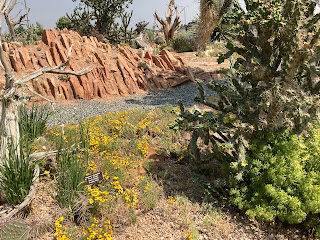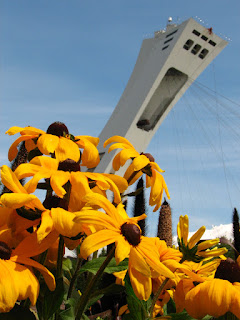Well folks, we've reached February. That means that spring, and the garden preparation that comes along with spring, is not
that far away. While we're still hunkered down indoors though, I thought we could take a moment and circle back to our friends, the houseplants. Through the bleakest parts of winter, our houseplants bring us life, joy, and a reminder of what's ahead. For those of us without a garden or yard, our houseplants play that role all year-round. So, in honor of our houseplants and the special place they hold in our hearts, let's talk about a few of my favorites!
Today, we're going to shine the spotlight on three plants with very unique foliage: the UFO plant (
Pilea peperomioides), angel wing begonia (
Begonia spp.), and triostar stromanthe (
Stromanthe sanguinea). All three of these plants are fairly easy to grow (note: the triostar stromanthe is a bit more particular about moisture), but if you're a beginner and want to start with some truly beginner-proof houseplants, check out our latest houseplant post
here.
UFO Plant (Pilea peperomioides).
Native to China, the UFO plant (Pilea peperomioides) has become a popular houseplant in recent years, largely due to its ease in propagation. While many houseplants are propagated via cuttings (which require time and patience as you wait for your cuttings to take root), the UFO plant also self-propagates by producing offshoots, or babies, at the base of the plant. These rooted babies can be easily separated and shared with others, giving this plant its other common name, "the friendship plant".
The UFO plant gets its name from its circular leaves, which extend from stems that are centrally attached to the base of the leaves. This type of leaf is referred to as "peltate", and gives the appearance of the leaves floating in space (hence, UFO). The leaves of this plant prominently grow towards the light, so you'll want to rotate your plant to keep it growing symmetrically. (In case you're interested in the mechanism behind this well-known phenomenon: a plant growth hormone called "auxin" concentrates where there is less light exposure, stimulating the growth of cells on the side of the plant that receives less light. As a result, the side that receives less light elongates, while the side that receives more light doesn't; together, this causes the plant to bend towards the light.)
Like many houseplants, this plant benefits from bright, indirect light; while it can adapt to less light, less light will likely result in a more leggy plant. You'll want to pot the UFO plant in a well-draining medium, such as one largely made of coir, and water every 1-2 weeks.
An angel wing begonia (
Begonia sp.
) cutting's first baby leaf!
The same angel wing begonia (Begonia sp.) from above, one year later.
There are many, many different kinds of begonias, but they can generally be separated into three groups based on the presence of underground storage organs. Of those three groups, the fibrous-rooted begonias contain some of the begonias we are most familiar with, such as wax begonias (often seen as annuals) and cane-like begonias (often seen as houseplants or annuals). Cane-like begonias, which are our focus for today, are also called angel wing begonias due to their wing-shaped leaves (as seen above). Cane-like begonias have jointed stems and, at every joint, you should find a leaf and/or a cluster of flowers, if in bloom. Some have polka dot-like spots on the foliage, which is why I find the leaves of this plant so unique and cool!
Due to the large variety of species and cultivars within the cane-like begonias, it can be difficult to identify a cane-like begonia down to the species/cultivar. You can see that I denoted my begonia as Begonia sp. for this very reason (sp. indicates that the species is unknown or doesn't need to be specified). Regardless of specific identification, cane-like begonias have similar needs to grow well. They generally do best in bright, indirect light, in a fertile soil, and they like to be watered as soon as the soil surface is dry to the touch. Cane-like begonias benefit from pruning or pinching in order to promote bushier growth.
Triostar stromanthe (Stromanthe sanguinea)
As its name implies, Stromanthe sanguinea (sanguinea means "blood red" in latin) features dramatic reddish-pink coloring, particularly underneath the leaves and at the base of its stems. The tops of the leaves hint at a pink color as well, although it is much more subtle as it blends into the white and green variegation. These glossy, colorful leaves make this plant an absolutely stunning houseplant, which is why I just had to buy it a few weeks ago. The triostar stromanthe, commonly also called "tricolor", has a mechanism by which it can position its leaves according to sun exposure, and also folds up its leaves at night, exposing the bright coloring underneath.
Native to the rainforests of Brazil, triostar stromanthes prefer warmer temperatures and humidity. During the growing season, it's best to keep the growth medium (which should be soilless) consistently moist. In contrast, the medium should have some time to dry out in between waterings during the winter. While bright light is best to maintain its bold coloring, triostar stromanthes can do very well in lower light as well. Unlike other houseplants we have discussed, propagate these plants by dividing the clump.
Do you have any tips for maintaining and propagating these houseplants? Let us know below!
References:
Guide to Begonias: https://edis.ifas.ufl.edu/publication/EP581
Cane-like Begonias: https://www.begonias.org/cane-like-begonias-like-bamboo-with-flowers/
Stromanthe sanguinea: https://hort.extension.wisc.edu/articles/stromanthe-sanguinea-tricolor/












.jpg)


